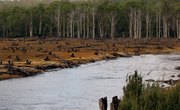Of the 14 ecosystems (also known as ecoregions or mega-habitats) defined worldwide, the continent of Australia is home to eight, including deserts, tropical and subtropical regions, mediterranean woodlands, temperate forests and grasslands, montane lands and tundra. The sheer size of Australia allows for a variety of vegetation and wildlife, and many of these groups have evolved in relative isolation, separated by features such as high mountain ranges.
Desert and Xeric Shrublands
The majority of Australia's central region is desert. One of the defining features of a desert is not necessarily that it does not rain, but that the rate of evaporation exceeds the rate of rainfall, creating a dry or xeric environment. Extreme temperatures are typical, as the lack of humidity and cloud cover creates often excruciatingly hot days and cold nights. Contrary to common belief, however, desert and xeric shrubland regions are home to a diverse array of habitats and wildlife. The plants that thrive here include gum and eucalyptus trees as well as hardy shrubs like acacia and saltbush. Wildlife include small rodents, mastiff bats, echidna, kestrels and many varieties of lizard.
Tropical and Subtropical Regions
A small area of Australia is home to tropical and subtropical broadleaf forests, thought to be remnants of the ecosystem that dominated Australia's landscape millions of years ago. Contrasting to desert regions, these have a more stable annual temperature and are dominated by evergreen deciduous trees. A much larger region, mostly in the north half of the island, is defined as the tropical and subtropical grasslands, savannas and shrublands. These areas don't receive enough annual rainfall to allow for tree cover, instead developing into one of the three subcategories, depending on area factors.
Mediterranean Forests and Woodlands
The south features a globally rare climate characterized by hot, dry summers and cool, moist winters. Though unusual, this ecosystem features an extraordinary diversity in plant and animal life, housing over 10 percent of the world's plant species. These include mallee scrub, eucalyptus and conifers.
Temperate Regions
Along the southeast coast, temperate ecoregions marked by cooler climates, high precipitation/humidity and deciduous plant life dominate. Like the tropical regions, there are several subcategories, including broadleaf and mixed forests (with an extremely wide range of variation in precipitation and temperature), grasslands, savannas and shrublands. However, temperate lands are very different from tropical, as they enjoy a much wider range of annual temperatures and unique wildlife.
The Extremes: Montane Lands and Tundra
Montane ecosystems are only a small percentage of Australia, occurring only at high elevations in the southeast. Montane regions tend to demonstrate stratified plant life with denser forests at more moderate elevations and sparser plant growth at higher elevations. Similarly, the tundra region is minimal, only found at high latitudes on Australia's sub-Antarctic islands. Plant life and wildlife is sparse here, limited to sedges and dwarf shrubs.
Related Articles
References
Writer Bio
Shannon Johnson has been a freelance writer since 2008, specializing in health and organic and green-living topics. She practiced law for five years before moving on to work in higher education. She writes about what she lives on a daily basis.











